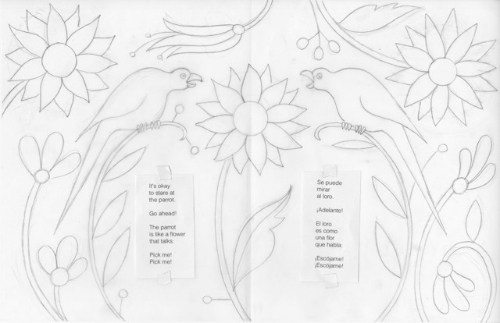
Several years ago, in order to illustrate Monica Brown’s Pablo Neruda: Poet of the People (Henry Holt, 2011), Julie Paschkis immersed herself in Neruda’s poetry and took Spanish language classes.
She fell in love with Spanish, its sounds and structure. Already a lover of words, she found these new words both interesting and fascinating, so much so, that she incorporated them in her paintings to stunning effect. She had created her own brand of visual poetry inspired by Neruda’s words.
Her love affair with the language didn’t end with that book. As one thing can sometimes beautifully lead to another, Julie discovered that her unfamiliarity with Spanish freed her to write poetry. The fourteen free verse animal poems in Flutter & Hum/Aleteo y Zumbido (Henry Holt, 2015) were first written in Spanish, then translated by Julie into English. And as she did with the Neruda book, she added words inspired by the poems to her illustrations.
In this exquisite tapestry of three languages — Spanish, English, and Art — we are treated to Julie’s charming insights and observations of creatures inhabiting land, sea and air, inviting us to appreciate them in new and surprising ways. Did you ever wonder what a turtle might be hiding in her shell?

TURTLE
The turtle hides
in her shell.
But maybe there is space,
a place
for hidden treasure.
Just for pleasure
she could put an emerald
and a ruby or two
there.
When she walks
she listens to the rattle of the gemstones.
That is why she goes so slowly —
she doesn’t want to spill
her secrets.
*
LA TORTUGA
La tortuga se esconde
en su caparazón.
Tal vez hay un vacío,
un espacio
para un tesoro escondido.
Sólo por gusto
la tortuga podría meter
una esmeralda y unos rubís
allí.
Cuando anda
escucha el traqueteo del tesoro.
Por eso ella anda lentamente —
para no deja caer
sus secretos.
And the snake? He writes “a slippery poem/with his body . . . He only knows one letter: ssssssssss.” There’s also a whale that dances “In a dazzle of bubbles.” Sheer delight!
The poems vary in mood from playful (a dog’s wagging tail “fans wild happiness/into the wild world”) to peaceful and evocative (“Out of the darkness/an owl hoots./An echo./The night train/is leaving”) to ethereal (“I am a fish in the sea of dreams”).

I really love the CAT:
Fat cat
naps on a map.
When she gets up
s h e s t r e t c h e s
from Arequipa to Zanzibar
and her belly bumps Topolobampo.
Elastic cat.
*
LA GATA
La gata gorda
se duerme en un mapa.
Cuando se levanta
s e e s t i r a
desde Arequipa hasta Zanzibar
y su barriga choca contra Topolobampo.
La gata elástica.
Isn’t ‘Topolobampo’ the best word ever? Even if we didn’t know it’s a city in Mexico, we get a good sense of how the cat’s moving in that winsome alliterative line, so much fun to read aloud. Flutter and Hum truly celebrates words, languages, and instinctual creative expression. It certainly contributes to our appreciation of how and where poems might emerge, and it’s fun to imagine Julie playing with both Spanish and English and exploring some of the magical places in between.


As someone who loves hand lettering, I fairly swooned over Julie’s gorgeous paintings. As words slither on long blades of grass, swirl in the ripples of pond water, ride atop the backs of crows (“crass/brash,” “craven/crooked,” “brujo/brusco”), float in clouds, adorn both halves of a juicy strawberry (“fresh, blush, ripe, giddy, gozo, julio, frivolo”), and stream in dark ocean waves (“nightfall, fill, flow, flung, luna, lustra, bunco, oscuro”), we hear these juicy words spark and sing, bask in their collective serenade, feel the heart quicken. Her careful choice of words, as well as how they are paired or juxtaposed, creates a new energy, another poetic revelation.
Readers will also enjoy the little touches of humor: the parrot is “cheery, cheeky, beaky,” the whale, “buoyant”/”oh boy,” and that irresistible cat, “now/then,” “here/there.” Surprise gifts in the fine details, a veritable feast of words. Perfecto!
I know you’ll enjoy hearing more from Julie herself, and we thank her for visiting today, and for creating this treasure of a book. Perhaps the turtle should stash a copy in her shell? 🙂
Continue reading →





 Since founding
Since founding 









